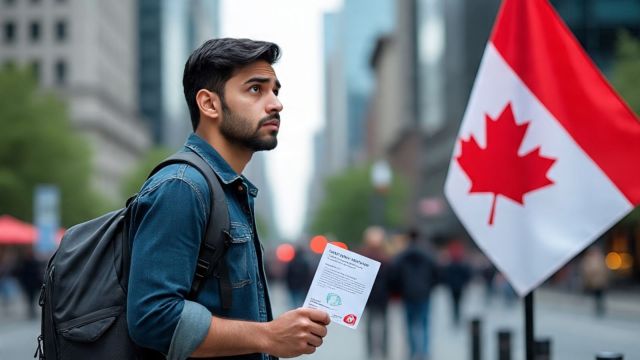This downward trend reflects growing challenges for both international students and temporary workers, hinting at stricter immigration policies and economic considerations.

 The data is presented on the official website of the Immigration, Refugees and Citizenship Canada (IRCC) and is as of June 30, 2025.
The data is presented on the official website of the Immigration, Refugees and Citizenship Canada (IRCC) and is as of June 30, 2025.
Between January and June 2025, arrivals fell by 2,14,520 compared to the same period last year. As mentioned on the official website of IRCC, 88,617 fewer new students arrived between January and June 2025 compared to January to June 2024 in Canada.
Story continues below this ad
Why Indian students face study abroad application rejection from Canada
On the other hand, 125,903 fewer new temporary workers arrived in the same period compared to January to June 2024. This decline highlights the “country’s ongoing efforts to maintain a balanced and sustainable immigration system,” as mentioned on its official website.
 The graph is taken from the official X account of IRCC.
The graph is taken from the official X account of IRCC.
Stricter rules squeeze students, strain services in Canada
Part of this reset has meant stricter rules for international students. Ottawa doubled the financial eligibility requirement for study permits, increasing the proof of funds from CAD 10,000 to more than CAD 20,000.
It also imposed caps on study permits, introduced a verification process for acceptance letters, and promised tighter scrutiny of admission documents to combat fraud. For many middle-income families, particularly in India, the higher financial bar has created what one consultant calls a “psychological barrier”.
Story continues below this ad
Ritika Gupta, CEO of AAera Consultants, said the sudden jump has been shocking. “For families in the middle-income range, this makes Canada feel less accessible. Many are second-guessing whether it is even worth the investment.”
Read | Sharp fall in Indian students going abroad: Canada, UK, US see first simultaneous drop in 4 years; here’s why
The economic implications of Canada’s tightening stance are already visible. As per news agency Reuters, international students contribute an estimated $16.4 billion annually to the economy, but colleges are now reporting falling revenues. Part-time jobs and gig work, once largely filled by international students, are harder to staff.
An experienced 41-year-old teacher from Delhi, based in Canada since 2019, described the current period as the worst she has experienced. Despite her permanent residency and professional background, she was laid off during pregnancy by a prominent tech company that is into teachers’ training. Since then, she has struggled to secure full-time employment.
Story continues below this ad
“International students brought more than just money — they also filled short-term teaching requirements. With fewer of them, both the tuition inflow and the workforce they provided have declined. Skilled teachers like me are now forced to take up temporary positions with no benefits or stability,” she said.
According to her, the school authorities are filling the 8-hour shift by assigning two teachers to four-hour part-time shifts, thereby avoiding the need to provide permanent teacher benefits.
Special needs education is also being hit as the supply of Educational Assistants shrinks. With budget cuts and staff shortages, many students with learning difficulties, such as dyslexia, are left without adequate support. Teachers often find themselves lowering the overall level of instruction just so that struggling students can keep up. For many families, the promise of high-quality education in Canada feels increasingly out of reach.
Even those who have already invested years in Canada are finding themselves stuck in limbo. A flight instructor from India who came in 2019 recalls that when she began training, student pilots could become instructors and eventually transition into permanent residency. That path was effectively closed in 2023, when Ottawa discontinued the Transport category after just two draws.
Story continues below this ad
“Now I have less than a year on my work permit, and I do not meet the Canada Comprehensive Ranking System (CRS) score for a Canadian Experience Class (CEC) draw. I’m in a tough spot,” she said, summing up the uncertainty faced by many who planned their futures around opportunities that no longer exist.
However, despite the present scenario, some students trust the system. An Indian student in Canada, Sainee Shankar, pursuing a postgraduate degree in Global Business Management at Humber College, is not worried about placement.
“My course is under co-operative education, which allows international students to combine their academic studies with paid, career-related work terms for professional experience. This can help me secure full-time employment as well. Also, with different connections like professors and referrals, I can get a job,” she said.
Accommodation has been a major concern post-pandemic. Sainee recalls an incident where her landlord misused a surveillance camera to harass tenants.
Story continues below this ad
Read | More than 55% international students faced difficulties finding accommodations in Canada
“When I came to Toronto from India, I was living in a flat, and the landlord would constantly monitor us through her camera — checking who was coming, who was going, and who was inside the flat. It raised serious privacy issues,” she said, adding that nothing could have been done except relocating, as the landlord consistently maintained that the check was important to keep the rented flat in good condition.
Difficult choices in front of students
Students aspiring to study in Canada are now faced with difficult choices — taking larger loans, front-loading bank debts, or shifting to cheaper programmes such as two-year diplomas. Some are even looking beyond Canada altogether, weighing options in countries like Germany, Finland, or Ireland, where proof-of-funds requirements are lower and living costs are more manageable.
According to Aritra Ghosal, founder of OneStep Global, stretched provincial services and reduced certainty around permanent residency have further dented Canada’s appeal.
Story continues below this ad
“Provinces like Prince Edward Island cut Provincial Nominee Program nominations by 25 per cent in 2024 to ease pressure, sending a signal that permanent residency pathways are less certain. Reputation also matters. When families weigh rising costs, uncertain residency outcomes, and negative global headlines, demand begins to soften even without policy tightening,” he said.
Ghosal noted that students now have three main strategies: restructuring finances by front-loading bank loans, showing larger family collateral — which increases debt burdens and financial stress — or considering programme switching.
“Programme switching allows students to shift to lower-fee institutions or two-year diplomas with less upfront cost. They can also look for destination diversification, exploring countries like Ireland, Finland, and Germany, where proof-of-funds requirements are lighter,” he added.
Industry observers say interest in Canada remains strong, but with a more cautious mindset.
Story continues below this ad
Gupta pointed out that while Canada continues to attract students with quality education and strong Indian and Asian communities, families are asking harder questions: whether permanent residency will remain realistic, or if other destinations offer greater certainty.
“Traditional strongholds such as Punjab and Gujarat may still show strong interest in Canada, but more students now keep a ‘Plan B’ — whether in the UK, Australia, the Gulf, or emerging European destinations,” he observed.
Ghosal agreed that Canada continues to appeal to those pursuing master’s or PhD programmes, but interest among diploma-seekers and middle-income families has cooled significantly.
“At the community level, there is growing anxiety among families who had traditionally viewed Canada as a clear pathway to education and long-term residency. With recent policy shifts, that sense of certainty has weakened, and the return on investment is being questioned more sharply,” he said.
Story continues below this ad
Looking Beyond Canada
Other countries are stepping into the vacuum. The upGrad Transnational Education Report 2024–25 shows that Germany is emerging as a strong alternative, attracting 32.6 per cent of Indian students considering Europe. Instead of committing to a single destination, students are now spreading their bets, balancing ambition with practicality.
Read | ‘We have seen a 30% increase in foreign applications’: French varsity Sciences Po Director
European countries are witnessing a surge in Indian interest, with Germany leading at 32.6 per cent, followed by Ireland (3.9 per cent), France (3.3 per cent), and another 9 per cent choosing other European destinations. Countries like France have launched several initiatives in the last three years to attract more Indian students, with a goal of hosting 30,000 by 2030.
Key steps include the new “Classes Internationales” programme at around 35 universities, offering foundation courses and intensive French language training to ease the transition for Indian high school graduates.
The government is also offering five-year Schengen visas to Indian alumni who complete a master’s degree or higher in France, strengthening long-term ties. A wide range of scholarships, such as the Charpak and Eiffel Excellence programmes, provide financial support.
The UAE is another rising star, with Indian students now making up 42 per cent of its international student population. Gupta observed that preferences often depend on student goals: the UK for short courses, Australia for its clear post-study work pathway, and Ireland for its growing tech hub.
Ghosal added that for many Indian students, countries like Ireland, Finland, and Germany remain attractive precisely because they demand less upfront proof of funds.



 The data is presented on the official website of the Immigration, Refugees and Citizenship Canada (IRCC) and is as of June 30, 2025.
The data is presented on the official website of the Immigration, Refugees and Citizenship Canada (IRCC) and is as of June 30, 2025. The graph is taken from the official X account of IRCC.
The graph is taken from the official X account of IRCC.






























